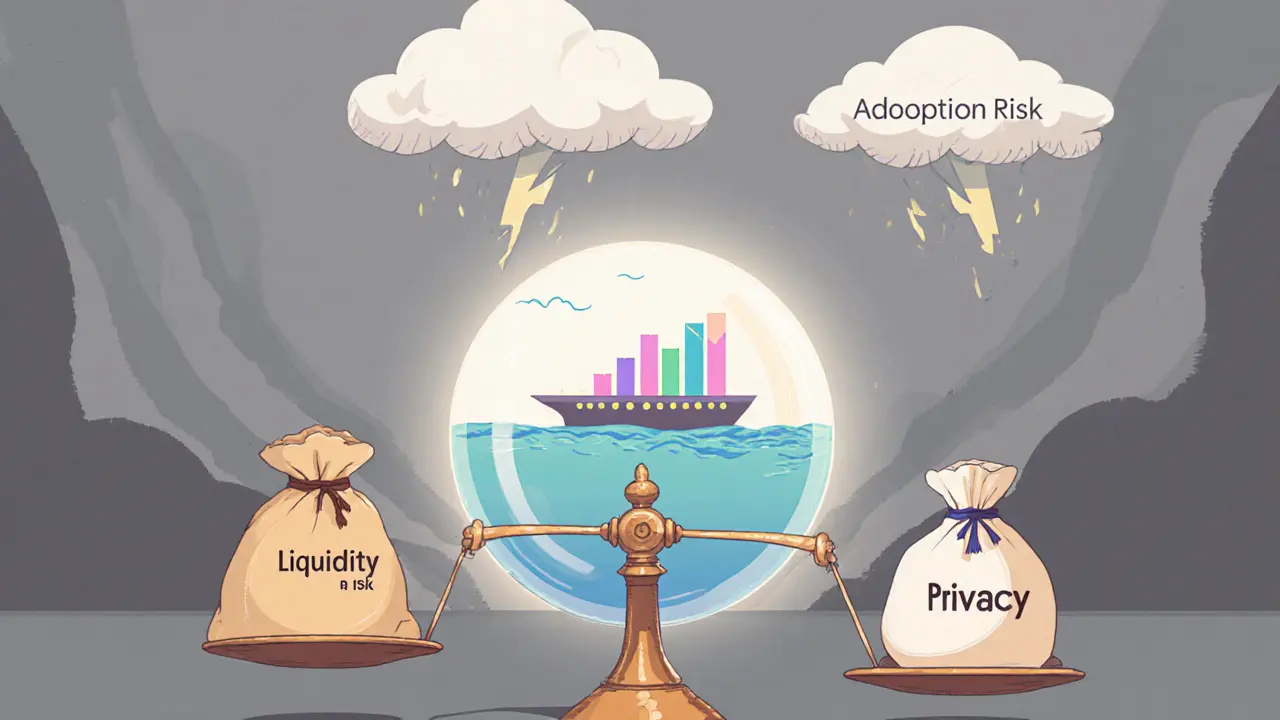Internxt (INXT) Token Value Calculator
Current INXT Token Metrics
Current Price:
Market Cap:
Circulating Supply:
All-Time High:
Price Change (24h):
-12.4%Calculate Your INXT Investment Value
Your Investment Summary
Tokens Owned:
Current Value:
Value Change Since ATH:
Percentage Change:
Feature Comparison Table
| Feature | Internxt | Siacoin (SC) | Storj (STORJ) |
|---|---|---|---|
| Encryption model | Client-side AES-256 + post-quantum | Client-side AES-256 | Client-side AES-256 |
| Blockchain base | Ethereum ERC-20 | Siacoin blockchain | Ethereum ERC-20 |
| Token price (Oct 2023) | $0.12 | $0.004 | $0.12 |
| Market cap | $0.13 M | $530 M | $850 M |
| Node count (public data) | ~700 token holders | ~12,000 hosts | ~7,500 hosts |
| GDPR compliance | Certified (audit by Securitum) | Partial | Partial |
| Post-quantum crypto | Yes | No | No |
When you hear the term Internxt is a peer‑to‑peer cloud platform that lets anyone store files securely on a distributed network. The system relies on the INXT token, an ERC‑20 cryptocurrency that pays the nodes keeping your data alive. In short, Internxt combines the privacy of client‑side encryption with the resilience of a blockchain‑driven storage market.
Key Takeaways
- Internxt offers a privacy‑first, decentralized cloud storage service called Internxt Drive.
- INXT is an ERC‑20 token used to compensate storage node operators.
- Security relies on client‑side encryption, file fragmentation, and post‑quantum cryptography.
- Market data (Oct2023) shows a circulating supply of 1,119,294INXT and a market cap around $130K.
- Adoption is limited: only ~700 token holders and low trading volume, making liquidity a concern.
What Internxt Is and Who Built It
Internxt started as a Spanish startup in 2017. Founder Fran Villalba Segarra earned a spot on Forbes30Under30 Europe that same year. He teamed up with CTO Alberto González and CMO Alejandra Arias to launch a platform aimed at giving users complete control over their data.
The flagship product, Internxt Drive, is available on Windows, macOS, Linux, iOS, and Android. It works like any regular cloud drive but all files are encrypted on the client before they ever touch the network.
How the Decentralized Storage Network Works
Internxt’s architecture can be broken down into three core steps:
- Client‑side encryption: When you upload a file, the app encrypts it locally using AES‑256 and a post‑quantum algorithm. The key never leaves your device.
- Fragmentation and distribution: The encrypted file is split into small shards (usually 250KB each). Each shard is sent to a different node across the globe.
- Redundant storage: Multiple copies of each shard are stored on separate nodes. If one node goes offline, the network can reconstruct the file from the remaining replicas.
Node operators run a lightweight storage daemon on their machines. They earn INXT tokens for providing disk space and bandwidth. The network’s open‑source code lives on GitHub, and a security audit by Securitum validates the implementation of the encryption stack.

INXT Token Economics
INXT is an ERC‑20 token on the Ethereum blockchain (contract 0x4a8f…4e16d4). Key metrics (Oct2023):
- Circulating supply: 1,119,294INXT
- Total supply: 1,319,294INXT (including a 200K reserve for future development)
- All‑time high price: $38.75 on 28Mar2021
- Current price: $0.1172
- Market cap: approx. $131K (CoinMarketCap) or $11.6K (CoinGecko)
The token functions purely as a utility token: users purchase INXT to pay for storage plans or to stake as node operators. There are no dividend or governance rights attached.
How Internxt Stacks Up Against Competing Decentralized Storage Solutions
| Feature | Internxt | Siacoin (SC) | Storj (STORJ) |
|---|---|---|---|
| Encryption model | Client‑side AES‑256 + post‑quantum | Client‑side AES‑256 | Client‑side AES‑256 |
| Blockchain base | Ethereum ERC‑20 | Siacoin blockchain | Ethereum ERC‑20 |
| Token price (Oct2023) | $0.12 | $0.004 | $0.12 |
| Market cap | $0.13M | $530M | $850M |
| Node count (public data) | ~700 token holders | ~12,000 hosts | ~7,500 hosts |
| GDPR compliance | Certified (audit by Securitum) | Partial | Partial |
| Post‑quantum crypto | Yes | No | No |
Internxt’s niche advantage is its post‑quantum encryption and a zero‑knowledge architecture that ensures only you can decrypt your data. On the flip side, its network is tiny, which means slower retrieval times and higher risk of storage loss if nodes drop out.
Pros and Cons of Using Internxt
Pros
- End‑to‑end encryption with post‑quantum protection makes it one of the most secure cloud options.
- Zero‑knowledge design guarantees that not even Internxt can see your files.
- GDPR‑compliant, appealing to European users concerned about data residency.
- Cross‑platform apps let you manage files from any device.
Cons
- Very low liquidity; buying or selling INXT on exchanges can be difficult.
- Small node ecosystem leads to slower upload/download speeds compared to centralized providers.
- Limited public documentation for node operators, raising the learning curve for contributors.
- Market cap under $150K signals minimal investor interest and raises questions about long‑term viability.

Step‑By‑Step: Getting Started with Internxt Drive
- Visit internxt.com and download the app for your OS.
- Create an account using an email address and a strong password.
- Purchase an INXT‑based storage plan or acquire INXT from a supported exchange (e.g., Binance, KuCoin).
- Allocate the tokens to your account; the app automatically converts them into storage credits.
- Drag and drop files into the Internxt Drive folder. The app encrypts, fragments, and distributes them instantly.
- If you want to become a node operator, install the Internxt Node daemon, stake the required amount of INXT (currently 10INXT per TB), and follow the on‑screen guide.
Even if you never run a node, the process feels similar to any consumer cloud service-just with an extra purchase step for the token.
Future Outlook and Risks
Decentralized storage is projected to grow to $142B by 2027, and privacy‑centric solutions could capture a slice of that market. However, Internxt faces three major hurdles:
- Liquidity risk: With virtually no 24‑hour trading volume, price swings can be extreme, making it hard for investors to exit.
- Adoption risk: The node network is under‑populated. Without more storage providers, performance and redundancy remain questionable.
- Development risk: Last major GitHub commit was in early 2023. A stagnant codebase may fall behind emerging security standards.
If the team can attract more node operators and list INXT on larger exchanges, the token might regain relevance. Until then, consider Internxt a niche tool best suited for users who prioritize absolute data privacy over speed or mainstream support.
Frequently Asked Questions
Is Internxt really decentralized?
Yes. Files are encrypted on the client, split into shards, and stored on independent nodes operated by community members. No central server holds a complete copy of your data.
Can I use Internxt without buying INXT?
You can sign up and test the app, but any paid storage plan requires INXT tokens. Some free trial credits are occasionally offered by the team.
How does post‑quantum cryptography improve security?
Post‑quantum algorithms are designed to resist attacks from future quantum computers. Internxt combines standard AES‑256 with a lattice‑based scheme, adding an extra layer that classical computers can’t break.
Where can I trade INXT?
INXT is listed on a few smaller DEXs such as Uniswap V3 and on niche centralized exchanges like LBank. Liquidity is low, so expect slippage.
Is Internxt GDPR‑compliant?
Yes. The company underwent an independent audit that confirmed its data‑processing practices meet GDPR requirements, including the right to be forgotten.


Mark Bosky
October 9, 2025 AT 09:13Internxt presents a compelling vision for privacy‑focused decentralized storage. By leveraging client‑side AES‑256 encryption combined with post‑quantum algorithms, the platform ensures that data remains inaccessible to unauthorized parties. The use of the INXT ERC‑20 token to compensate node operators creates an incentive structure that aligns economic rewards with service reliability. However, the current market capitalization of roughly $130 k indicates limited adoption and liquidity constraints. This low liquidity can result in pronounced price volatility, which may deter prospective investors seeking stable returns. From a technical perspective, the fragmentation of files into 250 KB shards promotes redundancy and resilience against single‑point failures. Yet, with only about 700 token holders acting as nodes, the network’s redundancy is comparatively modest. A modest node count also translates to longer retrieval times when accessing stored data. Prospective users should weigh the privacy benefits against potential performance trade‑offs. The platform’s GDPR‑certified status is particularly appealing to European users concerned with regulatory compliance. Moreover, the open‑source nature of Internxt’s codebase invites community audits and contributions. Nonetheless, the last substantial GitHub commit dates back to early 2023, suggesting a slowdown in development momentum. Should the team accelerate node recruitment and expand exchange listings, liquidity could improve markedly. In the interim, early adopters might consider allocating a modest portion of their portfolio to INXT to test the service. Such an approach balances exposure to the innovative technology with risk mitigation. Overall, Internxt offers a niche yet promising solution for those prioritizing absolute data privacy over raw speed.
Michael Phillips
October 10, 2025 AT 12:59When one contemplates the essence of decentralization, one must ask whether the value lies in the technology itself or in the collective trust of its participants. Internxt's approach illustrates a thoughtful balance between cryptographic rigor and pragmatic utility. Yet the sparse node network raises questions about the robustness of its redundancy model.
Jason Duke
October 11, 2025 AT 16:46Wow!!! Internxt really pushes the envelope, doesn't it??? The post‑quantum encryption is a game‑changer, and the tokenomics are fascinating, but wow-look at that market cap!!! It’s tiny, yet the potential is massive!!! If you’re not on board, you’re missing out!!!
Franceska Willis
October 12, 2025 AT 20:33Honestly, the vibe of Internxt feels like a cyber‑punk dream meets a privacy utopia. The encryption stack? Super slick, but the node count? Meh, kinda like trying to find a Wi‑Fi signal in a desert. Still, the post‑quantum bit? That’s lit! Might be worth a peek, even if the UI has a few gremlins.
EDWARD SAKTI PUTRA
October 14, 2025 AT 00:19I hear the concerns about liquidity and network size, and I understand why that would feel uneasy. It’s important to consider both the tech strengths and the market realities before diving in. Balancing optimism with caution can guide a wise decision.
Bryan Alexander
October 15, 2025 AT 04:06What a thrilling frontier! Internxt’s zero‑knowledge design feels like stepping into a secret vault, and the post‑quantum shield adds an epic layer of defense. Even with a modest node pool, the vision sparks excitement for a privacy‑first future.
Patrick Gullion
October 16, 2025 AT 07:53Sure, the token’s price looks shabby compared to its all‑time high, but that’s exactly why it could be a hidden gem. The market’s got it all wrong-decentralized storage is the next big wave, and Internxt is riding it quietly.
Jack Stiles
October 17, 2025 AT 11:39Nice take, but still kinda slow.
Ritu Srivastava
October 18, 2025 AT 15:26It’s morally indefensible to promote a platform that leaves users vulnerable due to an under‑populated node network. Privacy solutions must be robust, not half‑baked experiments. Supporting Internxt feels like endorsing complacency.
Nicholas Kulick
October 19, 2025 AT 19:13Internxt’s encryption is solid, but the limited node count may affect redundancy. Consider this when evaluating long‑term reliability.
Caleb Shepherd
October 20, 2025 AT 22:59Did you know the big exchanges are deliberately keeping INXT low‑key? It’s a classic move to keep the crypto elite in control while the rest of us miss out on the real gains. Keep an eye out for hidden listings.
Richard Bocchinfuso
October 22, 2025 AT 02:46Look, if you’re not buying INXT you’re basically supporting the status quo. The platform’s moral compas? It’s off the rails. Get off the T‑track and invest in something with real impact.
Monafo Janssen
October 23, 2025 AT 06:33Internxt bridges tech and culture, giving everyday users control over their data. The simple app makes it easy for anyone to start, regardless of background. It’s a step toward a more inclusive internet.
Marcus Henderson
October 24, 2025 AT 10:19The philosophical implication of owning one’s data cannot be overstated; Internxt endeavors to restore that agency. While the network size remains modest, the dedication to post‑quantum security reflects a forward‑looking ethos. Such commitment warrants cautious optimism.
Andrew Lin
October 25, 2025 AT 14:06America needs tech that doesn’t bow to foreign regulations, and Internxt’s decentralized model offers a glimpse of that sovereignty. If we don’t seize these opportunities now, other nations will dominate the data frontier. Let’s champion home‑grown privacy solutions before it’s too late.